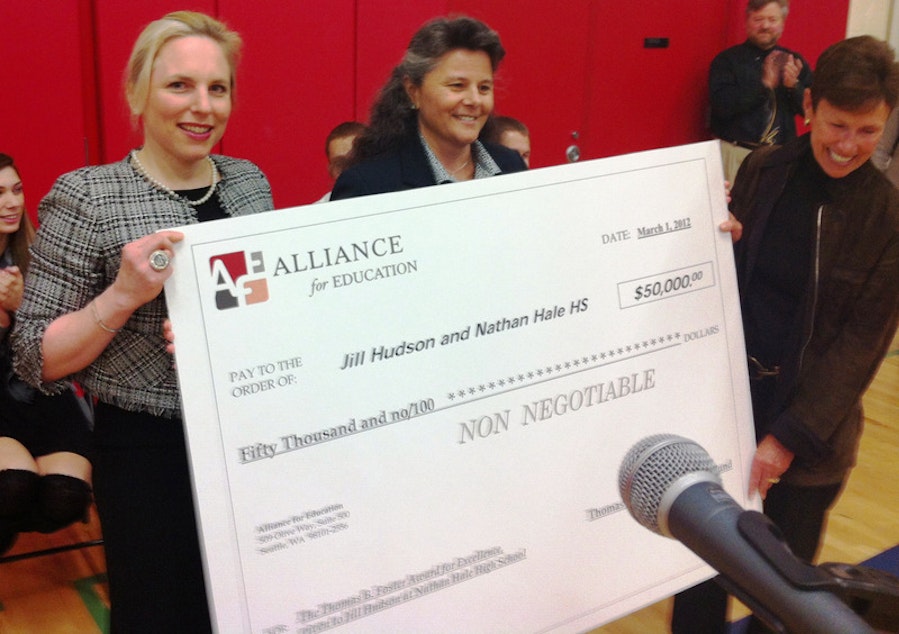Nonprofit Brings Support – And Pressure – To Seattle Schools

Clarification: This story has been changed to clarify School Board President Kay Smith-Blum’s thoughts on educational delivery models, including one advocated by the charter school company Rocketship Education.
In 1991, a small group of local CEOs sat down with Seattle Public Schools officials to ask how the CEOs could help the struggling district. "At that time Seattle Public Schools weren’t even wired – I mean, wired for telephones, in some cases. It was really sort of a Dark Ages problem," said Sue Tupper, the first executive director of the Seattle Alliance for Education.
Tupper says at the district's request, the group got schools hooked up with phone lines and Internet access. "When the organization started, there was great sensitivity to needing to take the cues from the school district, rather than coming up with an agenda and then imposing that agenda on the school district," Tupper said.
Today, that's the exact criticism you’ll hear about the current Alliance for Education at school board meetings.
When the district introduced its memorandum of understanding with the Alliance for school board approval last May, local education activist and blogger Melissa Westbrook challenged the official language during public testimony. "The Alliance is not part of the district," Westbrook told the board. "The wording in one paragraph is that 'the district remains on track with our goals.' The district is supposed to be on track with Alliance’s goals? No. It’s the other way around."
Sponsored
Alliance for Education President and CEO Sara Morris says the organization does support the district's goals. The Alliance can just differ on how to achieve them. "Really our work is to be what's known as the 'critical friend' of the district," Morris said. According to Seattle Public Schools, the Alliance has raised nearly $9 million for the district since 2007. It has also contributed a lot of advice about how schools should run. "We exist to support and improve public schools in Seattle," Morris said. "And we do that through an effort in finding just the right balance between support and pressure."
Morris says the Alliance applied that pressure effectively during the last teacher contract negotiation. "The contract that was passed contains every element but one of the original platform that we advocated for," Morris said. Those elements include using student test scores in the teacher evaluation process, a change that made many teachers unhappy. But Morris says her background as a marketing manager at Amazon.com taught her the value of being open to experimentation. "In the technology world, there is a real sense that is whatever is coming next is better. And I haven’t found that to be the case, necessarily, in education. That same mentality does not necessarily exist," she said.
Push For Experimentation
Morris says she’d like the district to consider the way the charter school company Rocketship Education teaches students -- by throwing out the conventional student-teacher ratio. "They’re doing some really incredible things, like having 40 or 50 children in a lab at a computer doing math, with a roaming tutor who can provide support as needed. That then allows them the flexibility to have six- and eight-student reading groups," Morris said.
Asked for her take on bringing the Rocketship teaching model to Seattle Public Schools, School Board President Kay Smith-Blum said although she wasn't "really educated" about the Rocketship model, "I don’t think anybody’s talking about putting 50 kids in a classroom."
Sponsored
One week after that interview, the Alliance for Education sent out invitations to its annual fundraising breakfast. The featured guest speaker is scheduled to be the CEO of Rocketship Education.
Later, in a follow-up email, Smith-Blum said she thinks schools "need to explore new delivery models" like the Rocketship approach.
Academic Researcher Urges Skepticism
National Education Policy Center Publications Editor and University of Colorado Boulder Education Professor Alex Molnar says business organizations like the Alliance for Education rarely have independently peer-reviewed research behind the education reforms they promote, like the Rocketship model. "They’re very, very hard-nosed with regard to results when they talk about teachers, schools and so on. But they’re very, very mushy when they talk about the evidence that supports what it is they’re proposing," Molnar said.
The largest-ever peer-reviewed study on the effects of class size on student learning found that elementary students did significantly better if they were in small classes of about 15 students.
Sponsored
When asked whether she seeks out peer-reviewed research in shaping the Alliance for Education agenda, Morris cited what she called "ample empirical evidence to suggest the status quo" is failing many students. To change that, Morris said, she’d like to see new attitudes in Seattle Public Schools. "Sort of a culture shift towards a 'we can do this, and this is how we’re going to get there' as opposed to 'we can’t, it’s their fault, it’s his fault,'" Morris said. "I’d love to see a little bit less of the blame game and a little bit more of the sort of affirmative 'this is not only what we can do, this is what we must do.'"
The school district is due to negotiate a new contract with its teachers this year. Once again, the Alliance for Education has a wish list of changes it wants the district to make. The organization is calling for student surveys as part of the teacher evaluation process, and for the district to get rid of its seniority system for teacher hiring decisions.
The new superintendent says he’ll consider the Alliance’s wish list, but that he’ll only make reforms that make sense for the district.

